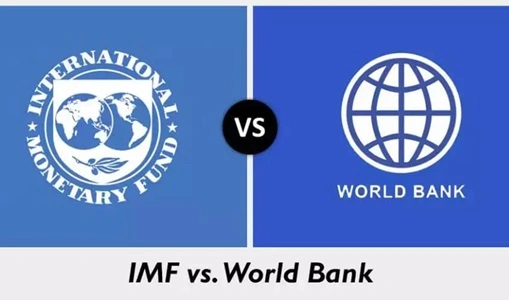You see, it is very common that when people hear terms like “IMF” and “World Bank,” they think that these are just the same things, but that’s not how it actually is. IMF and World Bank are two different organizations, though they do some things that are very similar to one another. Though, if you look at the bigger picture, both of these are somewhat different in why they exist, what they do, and how they conduct their operations. So, if you always wanted to know how these two money organizations actually differ from each other, then just keep on reading. Why? Well, we’re here just to mention all the major differences between the IMF and World Bank, so, here we go then.
First Of All, The Origin Story Of IMF and World Bank

Well, sure, both of these organizations differ in a lot of different aspects, but when it comes to their establishment, it was pretty much around the same time. Like, back in 1944, it was a crucial time when the world was just coming out of the effects of World War II, and since this war was a huge disaster for many nations around the world, these nations surely needed some help to rebuild and avoid such things in the future.
So what? Well, that is precisely why back in July 1944, the IMF (International Monetary Fund) and World Bank were created to help out countries that are highly in need of help, you know, to rebuild things, keep the economy stable, and fight poverty.
And just so you know, it is a huge similarity between these two organizations that they were born or established at the very same event, which was called the Bretton Woods Conference. Though, when it comes to their actual goals, they were slightly different from one another.
What They Actually Do
Well, here’s the first differentiating factor among these two organizations, so, let’s see.
IMF’s Job: Well, the IMF is mainly known for fixing the financial emergencies of countries around the globe, you know like, giving out short-term loans to countries that are currently going through some sort of money crisis or something like that. And if you’re wondering like why there is even a need to do something like this, well, just know that by doing this, the IMF makes sure that it can help stabilize currencies and avoid any big global economic problem. On top of that, the IMF also gives advice on stuff like how to fix national budgets, inflation, or debt issues.
World Bank’s Job: This is to offer long-term loans to countries for big but important projects like schools, hospitals, infrastructure, or something like that. In the end, this organization’s main aim is just to make sure they are helping to reduce poverty on a global stage, and that’s how they’re helping many nations’ economic growth.
How They’re Set Up
Oh, here’s another interesting way these two organizations are different from each other. Like:
IMF: To put it simply, the IMF is just one big organization with one big goal. That’s all. Like, as of 2025, it has 191 member countries, and it is funded by membership fees. So, as you can tell already, yes, the main decisions are made mostly by the member countries that contribute more money.
World Bank: It is not like the IMF, nah, instead, there are two main branches that are: IBRD (for middle-income countries) and IDA (for poorer countries). At present, though, there are only 189 member countries of the World Bank. When it comes to funding, well, it is mostly funded by the members but also by selling bonds in financial markets.
Who Pays and Who Gets Paid?
IMF’s Money Flow: It works like a simple equation actually, you know, where all the member countries contribute financially, and the ones in need can borrow from this pool of funds.
World Bank’s Money Flow: As we pretty much gave it off, the World Bank actually gets its funds from member countries and by selling bonds.
Macro vs Micro, Aka The Big Picture vs The Small Stuff
IMF: Well, IMF is mostly about the big picture stuff, you know, it looks at things such as nations’ budgets, currency rates, and international debts of the member countries.
World Bank: If we put it simply, you see, the World Bank is more like a “People-Centered” organization, which also helps countries develop and grow. All in all, this organization is more for humanitarian stuff.
Conditions & Criticism
IMF’s Strings Attached: When the IMF gives out loans, they usually have tough rules attached to them, like spending cuts or tax hikes. In criticism of that, expats say that this has some negative impacts on a nation’s education and health sectors, which directly impact the poor.
World Bank’s Mixed Reviews: Some argue that sometimes, with the actions of the World Bank, there have been displacement or environmental damage issues. While others say that this organization is actually heavily influenced by the rich countries around the globe.
Do The IMF And World Bank Come Together To Help?
In a way, yes, they do! A very recent example of that would be the COVID-19 Pandemic, where both of these organizations came together to help out so many countries around the globe. In big situations like these, both of these organizations help in their own way, like the IMF gives help to make sure the economy stays stable, whereas the World Bank mainly focuses on the recovery and rebuilding aspect in these nations.
Voting Power and Politics
In both the IMF and World Bank, rich countries have more votes, and that is not a criticism or anything like that; it is just pure fact. Like right now, the USA has the most influence, followed by nations like Japan, China, Germany, and the U.K. And now to the criticism part, well, many say that this is just an uneven playing field because power is distributed unevenly, which can be unfair in many scenarios. But there is not much that can be done for now, so that’s how it is.
Conclusion
There you have it. We truly hope that with these differences laid out right in front of you in plain and simple language, now you can better understand why these organizations exist, how they work, how they’re a huge help to many, and what problems or criticisms are there regarding these money organizations.

